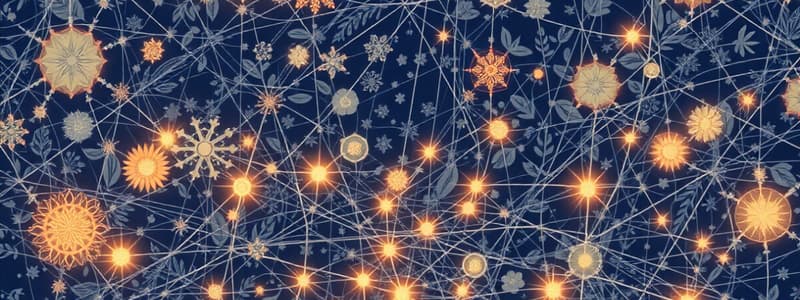Podcast
Questions and Answers
A host is an end system, while a router is a network device.
A host is an end system, while a router is a network device.
True (A)
The Internet is a hierarchy of networks, all connected by routers and switches.
The Internet is a hierarchy of networks, all connected by routers and switches.
True (A)
A wireless link is a type of communication connection that uses radio waves to transmit data between two devices.
A wireless link is a type of communication connection that uses radio waves to transmit data between two devices.
True (A)
The bandwidth of a transmission link is determined by the delay it introduces to data packets.
The bandwidth of a transmission link is determined by the delay it introduces to data packets.
The Internet is used for communication, but it is not used to support applications, such as social networking or online gaming.
The Internet is used for communication, but it is not used to support applications, such as social networking or online gaming.
Servers are never located inside data centers.
Servers are never located inside data centers.
Access networks are always wired.
Access networks are always wired.
Propagation delay is primarily determined by the length of the link and the speed of the signal.
Propagation delay is primarily determined by the length of the link and the speed of the signal.
Nodal processing delay includes the time spent queuing for transmission.
Nodal processing delay includes the time spent queuing for transmission.
Packet loss occurs when a router's buffers are full and arriving packets cannot be stored.
Packet loss occurs when a router's buffers are full and arriving packets cannot be stored.
The transmission delay for a packet is inversely proportional to the link's bandwidth.
The transmission delay for a packet is inversely proportional to the link's bandwidth.
A physical link is a physical connection between two devices, but it does not transmit data in the form of bits.
A physical link is a physical connection between two devices, but it does not transmit data in the form of bits.
Fiber optic cable is often used in point-to-point connections due to its high error rate, making it less reliable for long distances.
Fiber optic cable is often used in point-to-point connections due to its high error rate, making it less reliable for long distances.
Flashcards
Network Edge
Network Edge
The part of the network that includes end systems and access networks, enabling devices to connect.
End Systems
End Systems
Devices like PCs, servers, and smartphones that connect to networks and run applications.
Packet Switches
Packet Switches
Devices such as routers and switches that forward packets of data through the network.
Protocols
Protocols
Signup and view all the flashcards
Internet Standards
Internet Standards
Signup and view all the flashcards
Human Protocols
Human Protocols
Signup and view all the flashcards
Network Protocols
Network Protocols
Signup and view all the flashcards
Access Networks
Access Networks
Signup and view all the flashcards
Network Core
Network Core
Signup and view all the flashcards
Bandwidth
Bandwidth
Signup and view all the flashcards
Sources of Packet Delay
Sources of Packet Delay
Signup and view all the flashcards
Transmission Delay (dtrans)
Transmission Delay (dtrans)
Signup and view all the flashcards
Propagation Delay (dprop)
Propagation Delay (dprop)
Signup and view all the flashcards
Queueing Delay
Queueing Delay
Signup and view all the flashcards
Nodal Processing Delay (dproc)
Nodal Processing Delay (dproc)
Signup and view all the flashcards
DSL Access Network
DSL Access Network
Signup and view all the flashcards
Cable Network Access
Cable Network Access
Signup and view all the flashcards
Ethernet Access Network
Ethernet Access Network
Signup and view all the flashcards
Wireless Access Network
Wireless Access Network
Signup and view all the flashcards
Physical Media Types
Physical Media Types
Signup and view all the flashcards
Study Notes
Introduction to Computer Networking
- The textbook, Computer Networking: A Top-Down Approach, 6th edition by Jim Kurose and Keith Ross, is freely available to faculty, students, and readers.
- The PowerPoint slides can be used with modifications and additions.
- Users are asked to give credit for the source of the slides if utilized in a classroom setting or posted online.
- The content of the slides is based on the authors' work, and copyright is held by the authors.
Topic 1: What is the Internet ?
- The Internet is a network of networks.
- End systems are hosts (clients and servers) residing in data centers.
- Access networks connect end systems to edge routers.
- Communication links are different physical media.
- Packet switches forward packets.
Topic 2: Network Core
- Packet switching is used to forward data.
- Circuit switching is a different approach to data transfer.
- Network structure involves interconnected routers (interconnected ISPs).
- Interconnected systems and network structures exist.
Topic 3: Network Edge
- End systems include clients and servers.
- Access networks are physical media.
- Links are wired/wireless/etc., connecting devices within the edge.
Topic 4: Delay, Loss, and Throughput
-
Packets queue in router buffers.
-
Packet arrival rate can exceed link capacity: lead to delay and loss.
-
Packet loss occurs when buffers are full; packages are dropped.
-
Delay occurs because of transmission, propagation, nodal processing, and queuing delays.
- Transmission delay depends upon packet length and link bandwidth.
- Propagation delay is based on link length and propagation speed in the medium.
- Nodal processing delay considers checking bits, determining output link.
-
Throughput is the rate at which bits can be transferred.
-
Instantaneous throughput relates to rate at a given instant.
-
Average throughput is across a larger interval.
Topic 5: Network Protocols
- Protocols define message formats and order.
- Protocols dictate interactions between network entities.
- Protocols guide actions on message transmission and receipt.
Topic 6: Protocols and Internet Operation
- Protocols are necessary for communication in networks.
- Data transmission rate depends on bandwidth (R) and packet size (L).
- The concept of a message is broken into smaller packets transferred through a network.
Topic 7: Physical Media
-
Physical media includes guided (solid media) and unguided (radio link types) methods.
- Guided media like twisted-pair, coaxial, and fiber optic cables.
- Unguided media include radio/microwave links.
-
Media are crucial for communication networks.
Topic 8: Radio Link Types
- Radio link types are part of the guided/unguided media.
- Terrestrial microwave, LAN (e.g., WiFi), wide-area (cellular), and satellite links.
Studying That Suits You
Use AI to generate personalized quizzes and flashcards to suit your learning preferences.




